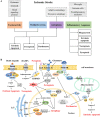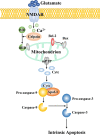Neuronal Death Mechanisms and Therapeutic Strategy in Ischemic Stroke
- PMID: 35513682
- PMCID: PMC9554175
- DOI: 10.1007/s12264-022-00859-0
Neuronal Death Mechanisms and Therapeutic Strategy in Ischemic Stroke
Abstract
Ischemic stroke caused by intracranial vascular occlusion has become increasingly prevalent with considerable mortality and disability, which gravely burdens the global economy. Current relatively effective clinical treatments are limited to intravenous alteplase and thrombectomy. Even so, patients still benefit little due to the short therapeutic window and the risk of ischemia/reperfusion injury. It is therefore urgent to figure out the neuronal death mechanisms following ischemic stroke in order to develop new neuroprotective strategies. Regarding the pathogenesis, multiple pathological events trigger the activation of cell death pathways. Particular attention should be devoted to excitotoxicity, oxidative stress, and inflammatory responses. Thus, in this article, we first review the principal mechanisms underlying neuronal death mediated by these significant events, such as intrinsic and extrinsic apoptosis, ferroptosis, parthanatos, pyroptosis, necroptosis, and autophagic cell death. Then, we further discuss the possibility of interventions targeting these pathological events and summarize the present pharmacological achievements.
Keywords: Ischemic stroke; Mechanisms; Neuronal death; Therapeutic strategy.
© 2022. The Author(s).
Conflict of interest statement
All authors claim that there are no conflicts of interest.
Figures








Similar articles
-
Mechanisms of neuronal cell death in ischemic stroke and their therapeutic implications.Med Res Rev. 2022 Jan;42(1):259-305. doi: 10.1002/med.21817. Epub 2021 May 6. Med Res Rev. 2022. PMID: 33957000 Review.
-
Cell Death Mechanisms in Cerebral Ischemia-Reperfusion Injury.Neurochem Res. 2022 Dec;47(12):3525-3542. doi: 10.1007/s11064-022-03697-8. Epub 2022 Aug 17. Neurochem Res. 2022. PMID: 35976487 Review.
-
An Updated Review of Mitochondrial Transplantation as a Potential Therapeutic Strategy Against Cerebral Ischemia and Cerebral Ischemia/Reperfusion Injury.Mol Neurobiol. 2023 Apr;60(4):1865-1883. doi: 10.1007/s12035-022-03200-y. Epub 2023 Jan 3. Mol Neurobiol. 2023. PMID: 36595193 Review.
-
The Role of Necroptosis in Cerebral Ischemic Stroke.Mol Neurobiol. 2024 Jul;61(7):3882-3898. doi: 10.1007/s12035-023-03728-7. Epub 2023 Dec 1. Mol Neurobiol. 2024. PMID: 38038880 Review.
-
Neuronal Injury after Ischemic Stroke: Mechanisms of Crosstalk Involving Necroptosis.J Mol Neurosci. 2025 Feb 4;75(1):15. doi: 10.1007/s12031-025-02313-y. J Mol Neurosci. 2025. PMID: 39903429 Review.
Cited by
-
A monoamine oxidase B inhibitor ethyl ferulate suppresses microglia-mediated neuroinflammation and alleviates ischemic brain injury.Front Pharmacol. 2022 Oct 13;13:1004215. doi: 10.3389/fphar.2022.1004215. eCollection 2022. Front Pharmacol. 2022. PMID: 36313349 Free PMC article.
-
Kynurenic acid protects against ischemia/reperfusion injury by modulating apoptosis in cardiomyocytes.Apoptosis. 2024 Oct;29(9-10):1483-1498. doi: 10.1007/s10495-024-02004-w. Epub 2024 Aug 17. Apoptosis. 2024. PMID: 39153038 Free PMC article.
-
Protective Effect of Beta-Carotene against Myeloperoxidase- Mediated Oxidative Stress and Inflammation in Rat Ischemic Brain Injury.Antioxidants (Basel). 2022 Nov 27;11(12):2344. doi: 10.3390/antiox11122344. Antioxidants (Basel). 2022. PMID: 36552554 Free PMC article.
-
The Involvement of Immune Cells Between Ischemic Stroke and Gut Microbiota.Transl Stroke Res. 2024 Jun;15(3):498-517. doi: 10.1007/s12975-023-01151-7. Epub 2023 May 4. Transl Stroke Res. 2024. PMID: 37140808 Review.
-
The miR-451a facilitates natural killer cell-associated immune deficiency after ischemic stroke.J Cereb Blood Flow Metab. 2025 Jul;45(7):1371-1384. doi: 10.1177/0271678X251321641. Epub 2025 Feb 22. J Cereb Blood Flow Metab. 2025. PMID: 39985210 Free PMC article.
References
Publication types
MeSH terms
Substances
LinkOut - more resources
Full Text Sources
Medical

